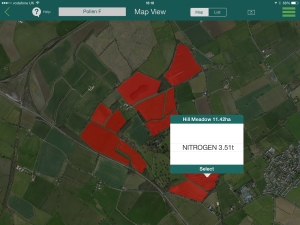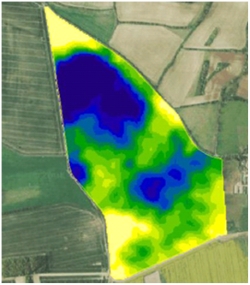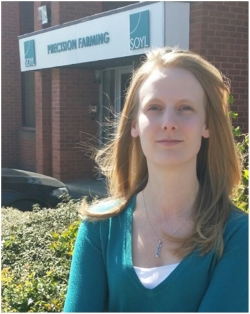SOYL Newsletter April 2015
1. iPad app update brings more benefits to growers iSOYL has been updated to include more features, making it even more valuable to variable rate application users.
iSOYL has been updated to include more features, making it even more valuable to variable rate application users.The app is a global first, allowing growers to manage their variable rate applications on an iPad to control equipment. Application files are seamlessly downloaded from the grower's mySOYL account, regardless of product, to an iPad and a corresponding 'as applied' record is uploaded afterwards.
iSOYL has a clear, easy to use interface and is compatible with most popular application equipment. Files are managed farm by farm and applicatiions shown on a field by field basis.
The update brings even more features to simplify precision crop production tasks. This includes the new ability to view all tasks as an overview map, as shown right, which allows the user to view all of the available tasks across all farms, or to select an individual farm as a graphical map as well as the existing field list.
Tom Parker, business development manager, explains, 'This is a really convenient way to be able to check that all your data is there before setting out to work and for contractors and farmers to be able to see the whole job as a map. It allows larger datasets to be viewed graphically rather than as a long list of filenames and the user can also select related tasks from the individual application map to see what else has been assigned to that field.'
A tour and help screens have also been added to help new and existing users with navigating the app and to demonstrate the full range of functions available. These screens appear on first opening but can also be accessed later via the menu. Every screen also has a handy help icon, which when tapped displays an overlay to show how to use every screen.
Other additional features include the ability to select product units for the as applied record and view completed application maps.
Existing users can download the latest version of iSOYL as a free upgrade.
The updated app is available now on the Apple App Store. Visit iTunes to download or www.isoyl.com for more information.
2. Still time to improve yields with variable rate N
 May has almost arrived but there are still at least four weeks of satellite image acquisitions remaining. These images could help identify variation in the canopy development of winter wheat and winter barley, enabling you to apply nitrogen where it's needed and achieve the best possible yield while minimising waste.
May has almost arrived but there are still at least four weeks of satellite image acquisitions remaining. These images could help identify variation in the canopy development of winter wheat and winter barley, enabling you to apply nitrogen where it's needed and achieve the best possible yield while minimising waste.By signing up to SOYLsense, growers can access all remaining images for this season with detailed data for individual farms, as well as the selection of satellite images of the UK that have been collected since mid February. SOYL's dedicated office team is also available to help manage any in-field variation, providing support and creating nitrogen plans for you if needed.
The team is now beginning to focus on creating the final applications for winter wheat and winter barley. These are treated with a field average reverse model which applies an increased dose to the thicker areas and a decreased dose to the thinner areas. This prevents over application to any areas that are non responsive to nitrogen and avoids yield penalties in forward areas which have previously been treated with two minimum doses.
For more information, please speak to your usual SOYL contact or call the SOYLsense team on 01635 204198.
3. All your questions answered at Cereals 2015
 Visit SOYL at this year's Cereals event to learn more about how precision crop production services can benefit your business. As well as demonstrations of the iSOYL app and online business management tool, mySOYL, the SOYL experts will be on hand to discuss your thoughts and queries around all things precision farming, including compatibility, getting started, soil science and product information.
Visit SOYL at this year's Cereals event to learn more about how precision crop production services can benefit your business. As well as demonstrations of the iSOYL app and online business management tool, mySOYL, the SOYL experts will be on hand to discuss your thoughts and queries around all things precision farming, including compatibility, getting started, soil science and product information.This year's event is on 10th and 11th June at Boothby Graffoe, near Lincoln, LN5 0AS. You can find us on stand 412.
4. Are you prepared for maize'
Many growers are turning to maize for AD plants, but it is important to be aware of the demands of the crop before taking it on. Maize puts on a tremendous amount of biomass in a relatively short period and is highly sensitive to nutrient deficits and soil structure, so knowing your land is prepared for this pressure is vital. If no muck has been applied in the last six months, there is still time for testing.
Good establishment is essential for a maize crop and any phosphate or manganese deficiencies will soon be evident as the crop develops. Phosphate in particular is needed for early vigour even in relatively high soil indices. Compaction will also cause unevenness and poor development; an electrical conductivity scanner can be used to see if soil types will cause any further problems or variation.
Once established, maize will place great demand on the major nutrients at the time of peak requirement and removals can be high depending on yield. Potash's peak requirement must be met and unless soil indices are very high, the significant crop removal must be put back. Magnesium, on the other hand, is only really required where soil indices are very low (0 or low 1) and then an application of Kieserite to the seedbed would be justified; 100-250kg/ha supplies 25-62.5MgO but also 50-125 SO3. Typical early symptoms of magnesium deficiency include chlorosis between the leaf veins which is quite diffuse. This occurs first on older leaves and the whole plant is then affected by leaf curling and severe chlorosis/necrosis, starting at the leaf tips and eventually leading to leaf death.
The table below shows the effect of nutrient removals on yield.

Micronutrients are also important in maize, especially zinc. Symptoms of zinc deficiency in maize appear as a distinct yellow striping of the leaves and 'whitebud' (a general white to yellow discolouration) may develop near the stalk. In cases of severe deficiency, the plants are stunted due to shortened internodes and the lower leaves show yellowish or reddish about one third of the way from the leaf margin. Manganese will cause streaky necroses on older and younger leaves. Cob development will be insufficient or irregular, often showing empty tips or diverse kernel size, as well as bent cobs.
SOYL can help you to identify opportunities for success with maize by:
- Carrying out a conductivity survey to determine soil type, defining areas for seed rate or cultivation changes
- Creating a nutrient map of the major nutrients and top up plans for any areas of deficit
- Conducting a field health check to obtain a general soil description and field levels of macro and micronutrients.
5. Meet Caroline Moore
 "I've been with SOYL since 2006 and as office manager, I have a variety of responsibilities.
"I've been with SOYL since 2006 and as office manager, I have a variety of responsibilities.As part of SOYL's senior management team, I've been involved in the system changes we have invested in over the past few years, such as streamlining our data processing, which have made a positive difference for growers in terms of efficiency and effectiveness.
I manage the PK mapping team in their day to day activities too. The team is responsible for delivery and quality control of the nutrient map process, from the GPS data collection in the field through to the final hard copy customer report. This data needs to be processed before the maps are available for customers to access online using mySOYL.
I also look after our head office at Newbury, which involves working with our health and safety manager to make sure the building is properly maintained in line with Frontier's health and safety standards. We have almost 30 staff based in Newbury and with visitors, this can sometimes double, so we need to make sure the environment is safe for everyone.
The challenges and opportunities that arise as SOYL continues to lead the sector in its use of precision farming solutions is one of the aspects I most enjoy about working here. There's always something new on the horizon and I enjoy looking for ways we can use what's available to improve our existing services and provide a better experience for growers."
Don't forget you can follow us on Twitter @SOYLprecision for regular updates on soils, nutrients, machinery and GPS.










